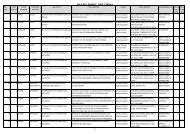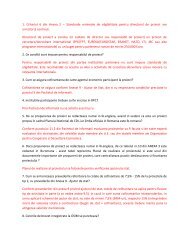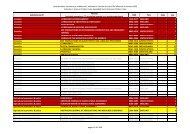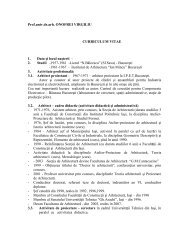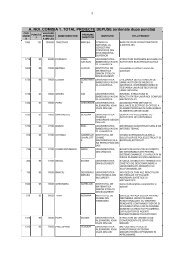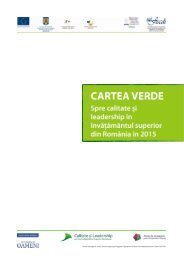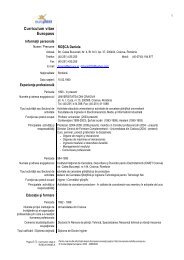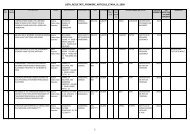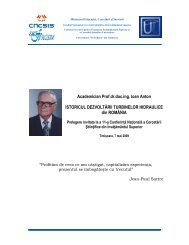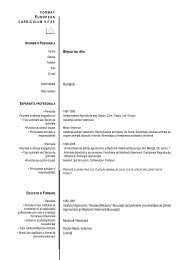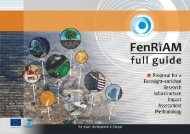Modul de formare-Managementul resurselor financiare - uefiscdi
Modul de formare-Managementul resurselor financiare - uefiscdi
Modul de formare-Managementul resurselor financiare - uefiscdi
- No tags were found...
You also want an ePaper? Increase the reach of your titles
YUMPU automatically turns print PDFs into web optimized ePapers that Google loves.
1.3.2. The financing of the public higher education institutions in the UK<br />
Until 1992, the Universities Funding Council and the Polytechnics and Colleges Funding<br />
Council were responsible for the funding of higher education institutions. Since 1992 Higher<br />
Education Funding Councils were foun<strong>de</strong>d at regional level.<br />
In addition to the core funding provi<strong>de</strong>d to the education and research, The Higher Education<br />
Funding Council supplements this funding with other funds for various purposes (to cover <strong>de</strong>bts<br />
inherited from the institutions previously un<strong>de</strong>r local authority control, the coverage of<br />
operational costs in the London area, the maintenance of libraries, museums, galleries, etc..).<br />
The Regional Council of Higher Education Funding allocates to the universities annual grants,<br />
largely <strong>de</strong>termined by a specific funding mechanism. The grants are awar<strong>de</strong>d in the form of<br />
global finance and they are internal distributed autonomous .<br />
Funds for education and research are strictly separated. Through the distribution of funds for<br />
education and research, Higher Education Funding Council seeks to maintain diversity and to<br />
<strong>de</strong>velop opportunities, encouraging efficiency in the use of the public funds.<br />
The higher education institutions receive public funds in the form of grants and subsidies to<br />
cover school fees awar<strong>de</strong>d by the Higher Education Funding Council 7 .The stu<strong>de</strong>nts with full<br />
frequency receive frequent government assistance for school fees, according to their family<br />
financial status.The stu<strong>de</strong>nts enrolled in postuniversitary courses involving only teaching and<br />
not a research activity are paying their school fees in full.<br />
However, the school fees of stu<strong>de</strong>nts enrolled in postuniversitary courses in research are<br />
covered - mostly - by the Research Council. More than 1 / 3 of the tuition fees of stu<strong>de</strong>nts with<br />
low frequency are paid by the employers.<br />
The education financing, the research funding and the subsidies granted to cover a part of the<br />
tuition fees are separate and in<strong>de</strong>pen<strong>de</strong>nt parts of the institutional allowance. The grants and<br />
subsidies granted to cover the school fees represent the public higher education resources.<br />
The mechanism for allocating funds for universities consist in four main stages 8 :<br />
1. <strong>de</strong>termining the standard resources for each institution<br />
2. <strong>de</strong>termining the current resources of the institution<br />
3. the comparison of the two levels and<br />
4. <strong>de</strong>termining the final grants<br />
For each institution of higher education, the standard resources are <strong>de</strong>termined based on the<br />
standard number of stu<strong>de</strong>nts and educational profile. In or<strong>de</strong>r to quantify the number of<br />
stu<strong>de</strong>nts it is consi<strong>de</strong>red the equivalent number of stu<strong>de</strong>nts with full frequency.<br />
A stu<strong>de</strong>nt with low frequency is quantified by comparing his educational activity with the one<br />
of a full frequency stu<strong>de</strong>nt. The stu<strong>de</strong>nts who are self-practice for a year outsi<strong>de</strong> the university<br />
are quantified by the rate of 0.5 / stu<strong>de</strong>nt, compared to an equivalent stu<strong>de</strong>nt with full frequency<br />
on that year.<br />
To <strong>de</strong>termine the standard financing for an institution for next year there are taken into account<br />
the number of potential stu<strong>de</strong>nts, admitted through competition for next year in addition to the<br />
existing number of stu<strong>de</strong>nts. Not all the stu<strong>de</strong>nts are fun<strong>de</strong>d in the same proportion. Factors like<br />
the stu<strong>de</strong>nts type and the nature of the study are leading to a different level of resources. Taking<br />
these factors into account in setting the standard resources, for each institution is granted certain<br />
7 Theisens H. (2003), Country report: Higher Education in the United Kingdom, CHEPS, , pg. 32-35, also<br />
available online at: http://utwente.nl/cheps/documenten/unitedkingdom.pdf, accessed on 12.03.2005.<br />
8 Theisens H. (2003), Country report: Higher Education in the United Kingdom, CHEPS, , pg. 32-35, also<br />
available on-line at: http://utwente.nl/cheps/documenten/unitedkingdom.pdf, accessed on 12.03.2005.<br />
9



